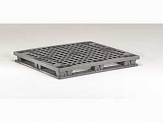We often take pallets for granted, but we shouldn’t. Pallets make it easy to move heavy loads of materials safely and efficiently. Yet they are a relatively new technology in materials handling.
 While loads of products have been moved on pallets since the development of the lift truck in the 1920s and ’30s, it wasn’t until World War II that these handy rectangular tools were used widely.
While loads of products have been moved on pallets since the development of the lift truck in the 1920s and ’30s, it wasn’t until World War II that these handy rectangular tools were used widely.
Stacking loads on pallets meant that fewer men were needed to move goods where they were required, freeing up more soldiers for active duty. Palletized loads also required less warehouse space, making depots operate more efficiently.
Pallet Management for Reducing Costs
The most common pallet size of 48″ x 40″ — called the GMA after its developer, the Grocery Manufacturers Association — wasn’t standardized until 1976. With this standardization, most pallets could be moved using any hand jack, power jack or forklift regardless of its final destination.
Over the years, pallets have evolved to fit their supply chain needs. Although wooden pallets are still used, they are slowly being replaced with pallets made with heavy-duty plastic that won’t splinter, split or present nail hazards that can cause product damage or worker injury during handling.
Pallets made of molded plastics are lighter than wooden pallets and are often stackable, reducing the amount of space they take up when not being used.
Pallet size and weight are considerations when it comes to lowering your transportation costs, such as fuel expenses. Pallets made of recycled plastic weigh up to 40% less than block pallets made of wood.
Benefits of High Quality Pallets
Low-quality pallets made of wood or even plastic can eventually fail, causing product damage or loss, injury and/or lost production time.
Pallet technology is improving all the time. Not only are modern pallets lighter and more versatile than older style pallets, but some even come with company logos and embedded Radio Frequency Identification (RFID) tags that help track inventory and control production with increased efficiency and reduced costs.
When you identify the right pallet for your operation, its use can be integrated for forklifts, automated production machines, conveyers and other steps in the production process.
When you distribute your pallets to your customers or to job sites, you want to make sure that the same pallets are returned to you so that they are the same size and type. That way they can seamlessly re-introduced into production without having to sort or store non-uniform pallets. Many companies will have their delivery drivers pick up the same number of pallets as they drop off, ensuring an eternal circulation system in which your pallet distribution matches your production.
